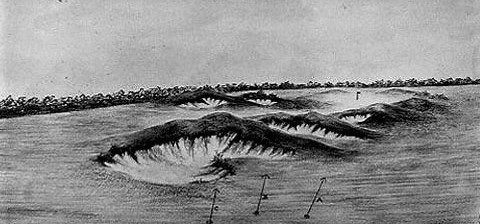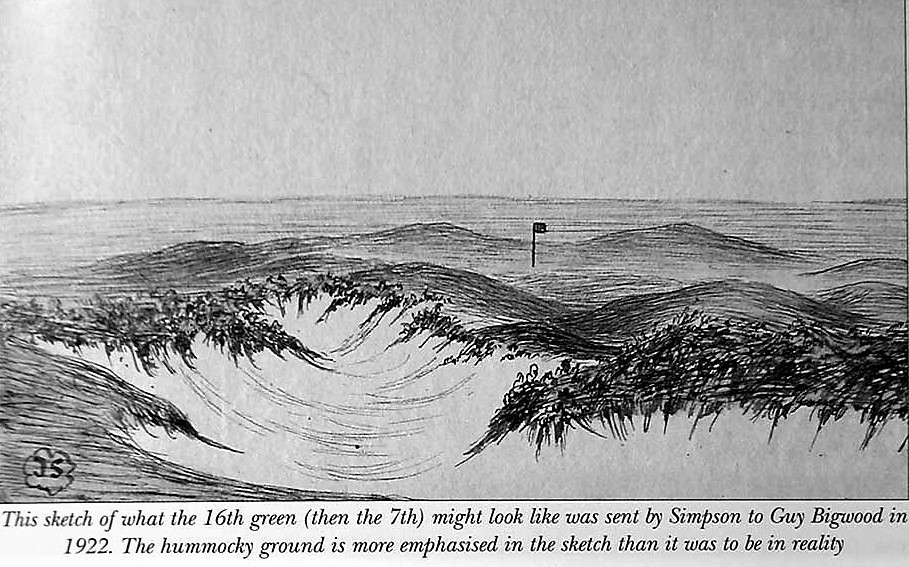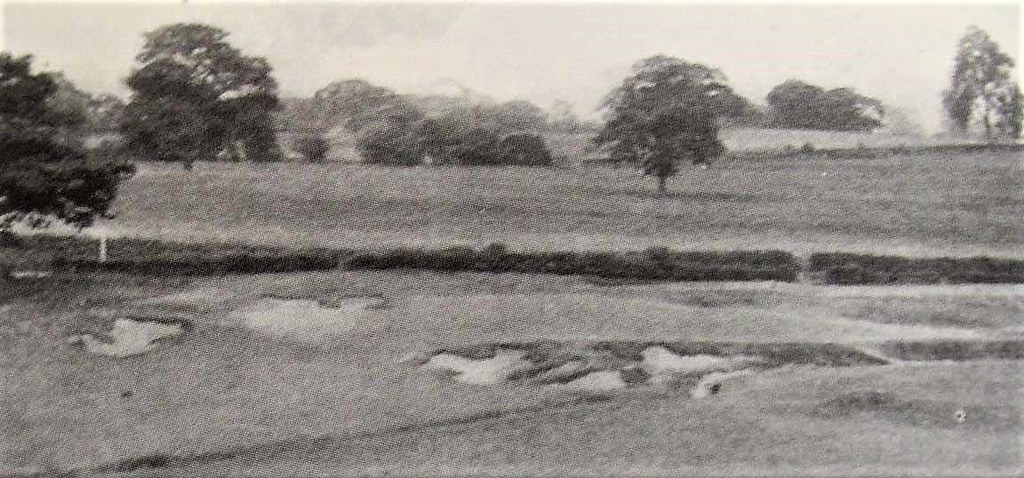

As evidenced by the professional's shop and scorecard, simplicity is the watchword of the club. There is also a simple display of Bobby Jones and Walter Hagen photos in the house. Blackwell is one of the few non-championship/championship qualifier rounds Jones played in England. A promise Jones made to Dr Bill Tweddell at the 1928 Walker Cup (they were opposing Captains) held at Chicago GC was kept the day after Jones won the 1930 Open at Hoylake. Despite finishing with mediocre scores of 74 and 75 on the final day, Jones hung on to win the Claret Jug. The game at Blackwell was surely a walk in the park!

The village of Blackwell in north-eastern Worcestershire is maybe 10 miles from the centre of Birmingham. On the edge of the village, in glorious farm country, Blackwell GC has a very modest number of members making the course readily available on most days. The course too is unusual in that it was designed by the team of Fowler and Simpson; a rarity in golf architecture. Fowler has enough famous designs in England to be a fairly well known in golf circles. Simpson on the other hand has very little remaining work in the British Isles and remains a figure shrouded in a bit of mystery. For certain Simpson was a controversial architect who enjoyed creating mischievous designs. For instance, according to Bernard Darwin, golfers in their ignorance did not like being teased by his “diabolical antics” and accordingly Simpson’s revisionary work at Sunningdale New was returned back to Colt’s plans by John Morrison. What we do know about Simpson can be gleaned from the many texts he authored, co-authored or contributed towards; perhaps the most famous being The Architectural Side of Golf co-authored with R Wethered. His views on golf most definitely leaned toward strategic, thinking man’s golf, but with flare. Simpson’s basic tenet was “The vital thing about a hole is that it should either be more difficult than it looks or look more difficult than it is. It must never be what it looks.”
Certainly, Blackwell isn’t what it looks as the course features deception and/or risky options throughout. Some of the above is due to bunkering, some to water hazards, some to green shapes and some to excellent use of perfectly rolling terrain. Looking at sketches Simpson prepared it is clear the architects intended to make a bold a statement at Blackwell. The bunkering schemes blended with the mounding rolling around the greens were to cause perceptual doubt and be stunning in appearance. Under the guidance of Infinite Variety, the club embarked on 10 year plan to renovate the bunkers and remove trees. An example is the bunkering on #10. While unquestionably deceptive, the original sketches demonstrate an elegance in the bunkering which the renovation has tried to recapture. The 11th, somehow comes nowhere near what the sketch represents and until recently completed work the result was one of the most bland holes on the course.

The 16th comes closer to the Simpson ideal, but none of the mounding which ties the bunkering together is present.

In any case, the reader has an idea of what Fowler and Simpson envisioned for Blackwell and quite remarkable the concept was. It is often the case that when clubs put their course under the knife for renovation that the urge to add yards here and there is too strong to resist. Kudos to Blackwell because there doesn't appear to be any such notion. Anyone who has played the course will know there is plenty of challenge as the SSS is one stroke higher than the par of 70.
Blackwell is one of the older clubs in Worcestershire being founded in 1893. The original 9 hole course was altered by Colt in 1912; soon after the club purchased 102 acres and wanted to expand to 18 holes. Designs were submitted by Colt and Fowler/Simpson and Fowler & Simpson won the commission perhaps because they envisioned a completely new design whereas Colt may have wanted to add nine holes to his current work. The nines were switched in the mid 30s. I am not sure why, but perhaps the club wanted to finish on a par 4 rather than a par 3. We shall also never know for sure how much of Blackwell is Simpson and how much is Fowler, not that it matters a great deal.


The first hole, while far from easy, is a mild opener playing blind over a hill. There is a sneaky bunker up the right which is reachable. Fowler and Simpson were hold outs to some degree as neither were adverse to blind features when the prevailing thinking was very much in the opposite direction. Although, Simpson disapproved of blind approaches. The second is a tough, uphill mid-length par three with the green sloping toward the front right. Evidence of a new bunkering style is on the left. I am not completely sold as I prefer the grassed-over style of the bunkers on the right (if renovated), but this is a minor issue. The bunkers are completely redone now and I think a second bunker was added on the left.

Since 2014 the club has been fairly aggressive in pushing out the grassing lines and to great effect. However, there are still areas where heavy rough is in play when a first cut or fairway would be more appropriate. Trees too are an issue the club has been tackling, but some sightlines to bunkers are still blocked by trees. This is the case on the very demanding 3rd, a brutal par 4 turning right and swinging steeply uphill. Below is the 3rd tee hanging above the 9th green. Trees etc have finally been cleared to open the view Hagen & A Compston saw in 1928.

The green-side bunkering creates a double dogleg effect which originally would have made the right fairway bunkers more meaningful with tree clearance. Below is a look at the two-tier green from the rear.

The first par 5 follows the property line down the left and is quite reachable in two if the golfer is willing to first take on the right fairway bunker and second, the clutch of bunkers short of the green. The fairway has been significantly widened to the right, but some outlier trees were oddly allowed to remain. Below is a look at the cross bunkers.

Turning right and continuing along the property line, the 5th features a well placed, but visually rather amateurish centre-line bunker. The green is quite interesting as it rises to a second tier that is mounded and then slopes away from play.

Behind the green prior to the bunker renovation.

The 6th is perhaps the best of a terrific set of short holes. This hole is strikingly similar to Edgbaston’s 3rd.


An up n' over short blind par 4 follows, however, a bunker is placed exactly on the line one needs to take if driving the green is the goal. Unfortunately, trees down the left make it exceedingly difficult to gain a good line of approach.

The next, a three-shotter curling left around a road and over a ditch is reachable in two, but the risks are very high. The hole parallels #3 and some good views of the house were opened up when were cleared. Below is the ditch which then (blind from the tee) runs across the fairway and up the right flank. Just for good measure there is OOB left.

The side finishes with another good par 3 and once again water is involved. Unusually, Blackwell features six holes with water, four of which see the water play a signifcant role. The horrible bushes/vegetation to the right of the green were removed to open a view to the third tee. Indeed, when Blackwell opened the entire hill between the 3rd tee and 1st fairway was void of trees; making for much better views from the house. The back right bunker was restored.

For those anxious about water, there is loads of space below the house to bail left. Long is not clever!

The back nine is seen by some as the better side and we get a sense of why immediately. The 10th bends strongly left against the terrain and the fairway bunkers look a doddle to carry, but in fact I reckon its about 250 yards. Originally, only the two lovely oaks stood on the right of the fairway making it much easier to bail right and be left with an awfully difficult second. The green beyond the fairway bunkers.


The 11th is a long, difficult par 3 heading in the same direction as the 10th. The removal of branches etc on the left has now made it possible to play a slight fade off the tee. The presence of the city is evident as the railway line is a few yards away on the left. The area left and in the background has been drastically cleared of trees. The final par 5 features the once incredibly long and sinewy bunker down the right. Originally the bunker was over 300 yards long, cutting across the fairway about 75 yards short of the green and continuing up the left to green high. I don't think this bunker was the work of Fowler/Simpson. I suspect the current line of the bunker used to be a drainage ditch. The bunker has been broken into four or five sections, perhaps to create bridges for trolleys to cross the sand. There is talk of reinstating the ditch. Combined with tree removal on the right this could be an excellent alteration.

An excellent mid-length par 3 which utilizes water very well; is there another classic era parkland course in Britain which features so much water? Two years after playing Blackwell Bobby Jones got stuck into ANGC and the famous short 12th hole. There is more than a passing resemblance to Blackwell's 12th. This photo is from the forward tee which offers a better view of the hole.

Despite the poor quality, this old photo reveals the accuracy of the restored 13th. The back left bunker is not reflective of Simpson's plan.

It was a stroke of genius to remove a tree or two to the rear of the green and fully open up the trouble when long.

The fine golf continues with #14. This is the third par 4 over 400 yards and like #3, plays longer because of the uphill approach. Swinging to the left, a bunker squeezes the inside of the leg. A mature tree near the ditch which made the approach very restrictive was removed. A house and a lane out of picture left do need tree protection, hence the mess of trees on the left. It would seem the club is reluctant to cut down tree(s) on the right, but with necessary encroachment on the left it seems like many trees should be removed. It would help the visuals on 15 as well.


Blackwell is fortunate to have a lovely set of greens.

Turning back on ourselves, we once again drive downhill over a ditch then approach to a green perched on a shelf. The walls of trees are doing their best to spoil the fine 15th.

I am not sold on the bunker work. Most of the bunkers are roughly the same size. Here we have bunkers lining up quite straight through the green. I fear the bunkers will have to be re-addressed.

Behind the green. I am not sure what the intent of the wavy fairway lines is....just looks weird to me. I would think grass lines should not be a point of focal attention.

Thinking the back of the course is now broken, we now face a hole that instead breaks the back of the golfer; 16 is 458 yards with blind fairway bunkering on the left, cross bunkers and greenside bunkers plus a dash of dead ground. I note the right hand fairway bunker was thankfully removed.
#17 is a short, but deadly par 4. There seems to be plenty of room off the tee, but in fact the fairway turns so sharply that a lay-up is prudent. This leaves an uphill assault over a washboard fairway to a fortress like green. Another superb hole on this very good back nine.
The final hole brings the golfer home in style. This moderate length two-shotter plays blind and downhill for the drive then turns left for home. The green rests on the corner of the house and any approach promises to gain the attention of loafers. I have never quite seen a set-up such as at Blackwell. The 9th green is just below the house to the left (out of picture), the first tee is directly outside the front door, the practice green is wrapped around the house just outside the spike bar and the 10th tee just beyond. An added touch of class is the house blocks the view of the car park which is a mere 25 yards behind the 10th tee! There is no question this arrangement is attractive and supremely functional. It is a wonder that archies these days don't deem it necessary to integrate the house with the course.

18th green from 10 tee. The practice putting green lies between the two. It might be a cool idea to combine the two greens.

There is a ton to like about Blackwell, especially the back nine. It is heartening to see the club taking strides to right the wrongs of tree encroachment and restrictive grass lines, however, there is a long way to go. The course is set in lovely countryside and many interior views could be recreated. There can be no doubt as to the merit of the design as holes the quality of 3, 6, 10, 13, 14, 15, 17 and 18 is a significant achievement on such a small plot of land. Additionally, the course has been deemed good enough to host Open Regional Qualifying for several years so it is clear there is a least a decent test of golf at hand - which is all the more remarkable because this par 70, 6260 yard layout required a mere 102 acres. I will certainly return to check up on the progress! 2024
Ciao